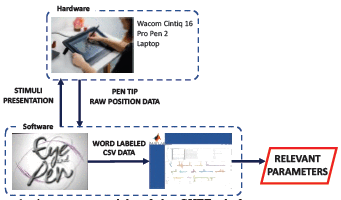Parameters Extraction
Provenzale, C., Sparaci, L., Fantasia, V., Bonsignori, C., Formica, D., & Taffoni, F. (2022, July).
2022 44th Annual International Conference of the IEEE Engineering in Medicine & Biology Society (EMBC) (pp. 5128-5131). IEEE.

Abstract:
Handwriting is an important component of academic curricula and grapho-motor skills (GMS) support learning, reading, memory and self-confidence. Teachers and clinicians report increase in children experiencing problems with acquiring fluid and legible handwriting. To date gold-standard tests evaluating children's GMS, mostly rely on pen and paper tests, requiring extensive coding time and subject to high inter-rater variability. This work presents preliminary data on a new digital platform for Grapho-motor Handwriting Evaluation & Exercise (GHEE), attempting to overcome limitations of available digitalized methods for GMS evalution. In fact, contrary to previous systems, GHEE design originated from comparisons among multiple standardized tests and was based on a human-machine interaction approach. GHEE hardware and software is presented as well as data on preliminary testing. Cursive handwriting data from six adult volunteers was analyzed according to six parameters of relevance, both automatically (i.e., using GHEE software) and manually (i.e., by a human coder). Comparisons among machine and human data sets allowed parsing out parameters to be extracted automatically and parameters requiring human-machine interaction. Results confirmed platform efficacy and feasibility of the proposed approach.
